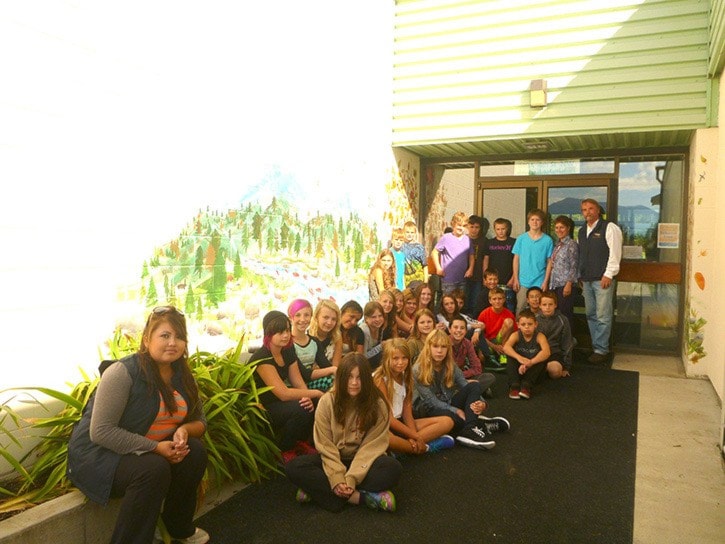Salmon now have human representatives travelling the Columbia Basin carrying the message about the importance of fish life in the watershed.
The Salmon Ambassadors arrived at Nakusp Elementary on Thursday, Sept. 19 bringing word of the fish’s history and what the construction of dams along the Columbia has meant to the salmon.
Gerry Nellestijn and Nevada Nicholas wore vests identifying them as the fish ambassadors, and they introduced the underwater world to Leslie Leitch’s grade seven class. Their tour of schools in the Basin is in advance of the Columbia Salmon Festival taking place in Invermere on Sept. 28, which has the mission to inform people about the history and future of salmon in the upper Columbia.
Nellestijn and Nicholas did their part, first going through the salmon lifecycle with the class who had just been to the Hill Creek hatchery and spawning channel.
Back in the day, as shown by a spectacular historical slide in the presentation, Chinook salmon were fished in Salmo. In fact, there were all kinds of salmon that swam the waters of the Columbia before the dams were built. Steelhead, Sockeye and Chinook all migrated down to the ocean and back up to the headwaters of the Columbia at Canal Flats.
Between 16 and 22 million salmon used to navigate the Columbia, the ambassadors told the students, but according to the last census there are now only 2.5 million fish.
The odds of survival from egg to spawning salmon are slim: for every 7,500 eggs, only four adults make it, and half that return to spawn. But no egg, alevin, or fry is wasted, as each stage of life the salmon become food for the many species of plants, birds, bears and other animals that thrive along the Columbia.
Which is another reason there is so much concern about restoring the salmon to some of their former glory. Their part in the cycle of life is vital, and their importance to the First Nations people here reflects that significance.
When the dams were built, the first in 1937, the First Nations were not consulted, although they soon felt the effects. Imagine suddenly there was no Overwaitea, Ambassador Nicholas said to the students. That’s kind of what it was like for the people who were living along the Columbia: there was no more food for them or for bears which were another source for food and more.
But not all hope is lost. Thanks to technology such as fish ladder and vacuums, and more, the salmon could make a comeback, said Nellestijn. All it could take is students like those in Leslie Leitch’s class thinking about solutions, becoming involved with conservation and spreading the word that fish are important: becoming a salmon ambassador.
